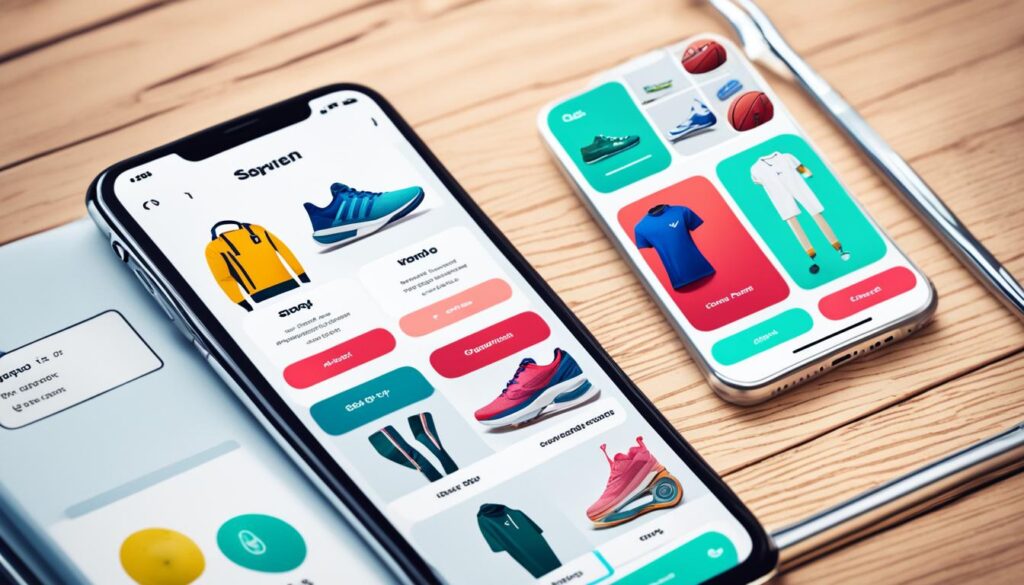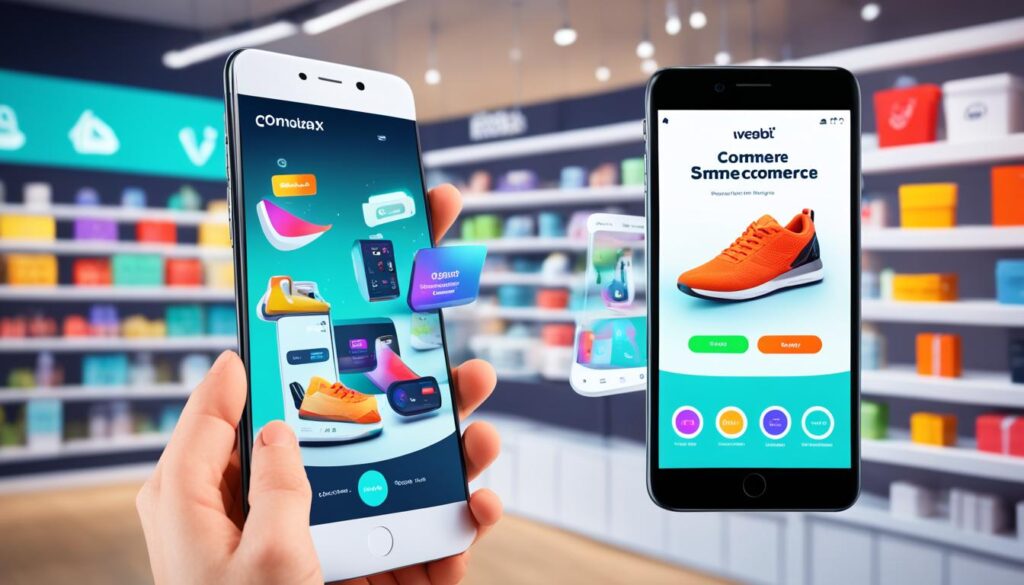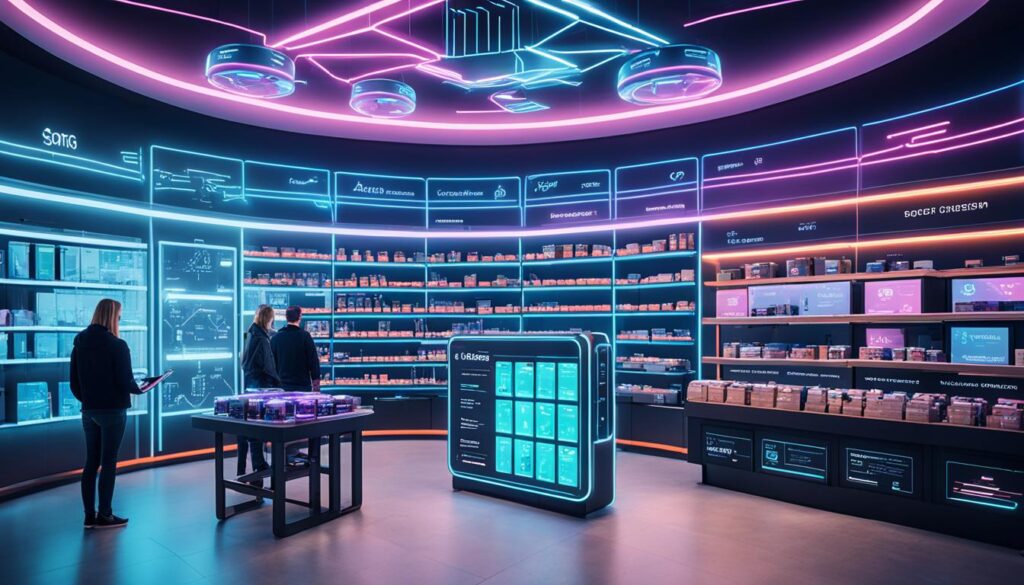E-commerce has changed the way we shop, with mobile apps leading the charge. These apps are key to the future of online shopping. They offer smooth, tailored, and deep shopping experiences. The e-commerce mobile app world is seeing new trends that meet what customers want and use new tech.
This article looks at the top trends changing the e-commerce mobile app scene. These trends help businesses keep up with today’s digital shoppers.
Table of Contents
Key Takeaways
- Mobile apps are becoming more important in e-commerce. People use them for easy and personalized shopping.
- New trends in e-commerce mobile app development focus on making shopping personal and relevant.
- Augmented Reality (AR) and Virtual Reality (VR) are being added to apps for better product views.
- Artificial Intelligence (AI) and Machine Learning (ML) make shopping more personal with smart recommendations and chatbots.
- Voice-based shopping and search are new areas in e-commerce mobile apps.
Introduction to E-commerce Mobile App Development Trends
Mobile commerce has grown fast, changing the way we shop online. Now, mobile apps are key for any online store’s success. They help increase sales, keep customers engaged, and make shopping smooth. As what customers want from online shopping changes, it’s vital for businesses to keep up with mobile app trends.
The Significance of Mobile Apps in E-commerce
E-commerce mobile apps have changed the game. They offer a convenient and personalized way to shop, boosting mobile commerce growth. Today, mobile apps make up over 70% of all online sales, showing their big role in this trend.
Evolving Consumer Demands Driving Innovation
As what customers want from online shopping changes, businesses must innovate with mobile apps. They need to offer personalized shopping, use new tech like augmented and virtual reality, and make payments easy. By meeting these needs, e-commerce companies can keep customers coming back and grow their sales.
| Key E-commerce Mobile App Trends | Impact on Consumer Behavior |
|---|---|
| Personalized Shopping Experiences | Increased engagement and loyalty |
| Augmented Reality (AR) and Virtual Reality (VR) Integration | Immersive and interactive shopping experiences |
| Seamless Payment Solutions | Improved conversion rates and customer satisfaction |
“The future of e-commerce lies in the seamless integration of mobile apps, innovative technologies, and evolving consumer preferences.”
Personalized and Contextual Shopping Experiences
The world of online shopping is changing fast. Now, personalized e-commerce experiences and AI-powered personalization are key. They help deliver content and recommendations that match what customers like and do.
Customers want contextual shopping. They want online stores to show them products that fit their interests and where they are. By using customized product recommendations, stores can make shopping more fun and easy. This leads to more sales and loyal customers.
Location-based services in e-commerce make shopping even better. Now, apps can show products and deals based on where you are. This makes shopping smooth and relevant for customers.
| Key Personalization Strategies | Benefits |
|---|---|
| Predictive product recommendations | Increased conversion rates and customer engagement |
| Personalized content and offers | Improved customer loyalty and retention |
| Location-based services | Enhanced relevance and convenience for customers |
By using these trends, online stores can make shopping fun and rewarding. This helps them grow and succeed in a tough market.
Augmented Reality and Virtual Reality Integration
E-commerce is changing fast with augmented reality (AR) and virtual reality (VR). These technologies are making shopping more fun and interactive. Now, customers can try on products virtually and see them in real-time.
This mix of AR/VR in e-commerce helps shoppers make better choices. It also cuts down on returns and makes brands more engaging.
Immersive Shopping with AR/VR
AR and VR are changing how we shop online. With their help, customers can try on clothes and accessories on their phones. They can see how things will look and fit before buying.
This new way of shopping boosts confidence and lowers returns. It’s good for both shoppers and stores.
Real-time Product Visualization
3D product visualization lets customers see products in real size and setting. Thanks to augmented reality in mobile commerce, shoppers can check out furniture and appliances at home.
This makes shopping more informed and builds brand loyalty. Seeing products in real-time makes the shopping experience better.
“The integration of AR and VR in e-commerce is transforming the way we shop, allowing us to immerse ourselves in the products we love and make more confident purchasing decisions.”
Artificial Intelligence and Machine Learning
In the world of e-commerce mobile apps, artificial intelligence (AI) and machine learning are changing how we shop. These technologies help e-commerce businesses offer personalized product suggestions, smart chatbots, and virtual assistants. They meet the needs of today’s shoppers in new ways.
Personalized Recommendations
AI and ML let e-commerce apps study what customers buy and look at. They use this info to give personalized product recommendations. This makes shopping better and can lead to more sales and loyal customers. People like getting products that fit their tastes and needs.
Intelligent Chatbots and Virtual Assistants
Intelligent chatbots and virtual assistants are changing how we get help in e-commerce apps. These AI tools give quick, personal help to customers. They answer questions, suggest products, and help with buying things. This makes customers happier and helps businesses save time for other important tasks.
“AI and ML are the driving forces behind the next generation of e-commerce mobile apps, empowering businesses to deliver truly personalized and intelligent shopping experiences.”
The use of AI and ML in e-commerce apps will keep growing. By using these technologies, businesses can offer better shopping experiences. They can give customers personalized advice and support, which can lead to more sales and loyal customers.
Voice-based Shopping and Voice Search Optimization
Voice-based shopping and voice search are getting more popular in e-commerce. Savvy retailers are making their mobile apps work better with voice commands. This makes shopping easier and more fun for customers.
Shopping with voice has many benefits. It’s easier to get things, faster, and more personal. Customers can search for products, compare prices, and buy things without using their hands. This makes shopping smooth and efficient.
For retailers, making apps work well with voice search is key. They need to make sure products and search functions work with voice commands. This means using smart tech to give customers what they’re looking for quickly and accurately.
As more people shop online with voice, businesses must keep up. They need to make their apps ready for voice shopping. This means making sure products and search results are easy to find with voice commands.
By doing this, retailers can connect better with customers and grow their online sales. They can offer a shopping experience that’s easy and fun. Optimizing e-commerce mobile apps for voice is a smart move for staying ahead in online shopping.
“Voice search is the future of e-commerce, and brands that fail to optimize their mobile apps for this technology will be left behind.”
Progressive Web Apps (PWAs) and Hybrid Apps
In the world of e-commerce, two trends are changing the game: progressive web apps (PWAs) and hybrid apps. These technologies are making e-commerce mobile shopping better and more engaging for customers.
Benefits of PWAs and Hybrid Apps
PWAs and hybrid apps bring many benefits for e-commerce businesses. They mix the good parts of mobile apps and web apps. This gives users a better experience that can lead to more engagement and sales.
- Improved performance: PWAs and hybrid apps load fast and work well even on slow networks.
- Enhanced user experience: They give a feel like a native app, with offline use, push notifications, and easy navigation, all online.
- Increased accessibility: These apps can be used by more people, on any device with a web browser, without needing app store downloads.
- Cost-effective development: Making PWAs and hybrid apps is cheaper than making separate apps for iOS and Android. This saves money for e-commerce businesses.
- Improved mobile experiences: Using PWAs and hybrid apps, e-commerce businesses can offer better mobile shopping experiences. This makes shopping on mobile better for customers.
The e-commerce world is always changing. The benefits of PWAs and hybrid apps make them great choices for businesses wanting to improve mobile shopping. They help businesses stay ahead and give customers the best mobile shopping experience.
Top Trends in E-commerce Mobile App Development
The e-commerce world is always changing, and [https://www.apptunix.com/blog/the-latest-e-commerce-app-development-trends-you-need-to-know/] mobile app trends are leading the way. These trends include personalized shopping and the use of new tech like augmented reality (AR) and artificial intelligence (AI). They’re changing how we shop online.
One big trend is making shopping more personal. E-commerce apps use data and learning algorithms to give users product suggestions and special deals. This makes shopping more fun and keeps customers coming back.
AR and VR are also big news in e-commerce. They let users see products in real life before buying them. This helps people make better choices and lowers the chance of returns.
AI is making customer support better too. AI chatbots and assistants help customers right away, making shopping smoother and more satisfying.
More people are using voice search and PWAs to shop. Voice search lets you shop without using your hands. PWAs give you the ease of apps but work like websites.
| Trend | Description | Key Benefits |
|---|---|---|
| Personalized Shopping Experiences | Leveraging data analytics and machine learning to offer tailored product recommendations, customized user interfaces, and personalized promotions. | Enhance customer engagement and loyalty, improve conversion rates, and increase overall customer satisfaction. |
| AR/VR Integration | Integrating augmented reality and virtual reality functionalities to enable real-time product visualization and immersive shopping experiences. | Improve product discovery, reduce return rates, and enable more informed purchasing decisions. |
| AI-powered Features | Implementing intelligent chatbots, virtual assistants, and other AI-driven solutions to provide personalized customer support and streamline the shopping experience. | Enhance customer satisfaction, improve operational efficiency, and reduce customer service costs. |
| Voice-based Shopping | Optimizing e-commerce mobile apps for voice search and integrating voice-enabled features to enable hands-free, seamless shopping experiences. | Improve accessibility, increase convenience, and cater to the growing demand for voice-based interactions. |
| PWAs and Hybrid Apps | Developing progressive web apps (PWAs) and hybrid apps that combine the benefits of mobile apps and web-based platforms. | Offer the convenience and functionality of mobile apps with the accessibility and discoverability of web-based platforms. |
By keeping up with these e-commerce mobile app development trends, businesses can make apps that are both fun and effective. These apps can make shopping better and help businesses grow in the competitive [https://www.apptunix.com/blog/the-latest-e-commerce-app-development-trends-you-need-to-know/] mobile commerce world.
Mobile Wallets and Secure Payment Gateways
In the fast-changing world of online shopping, mobile wallets and secure payment gateways are key. More people use their phones for easy shopping. So, online stores must offer a smooth checkout process. By using mobile payments, stores can give customers a safe and easy way to pay, making shopping online better.
Seamless and Secure Payment Solutions
Mobile wallets like Apple Pay, Google Pay, and Samsung Pay have changed how we buy things online. They make paying easy and safe, letting customers pay with just a few taps on their phone. Also, secure payment gateways make online shoppers feel safe, helping them buy without worry.
Putting mobile wallets and secure payment gateways together has made checking out online smoother. It cuts down the steps to pay, helping stores get more sales and keep customers coming back.
As online shopping grows, using mobile payments and secure gateways will be key. Stores that offer easy and trusted payments will do well in the changing online market.
| Mobile Wallet | Key Features | Adoption Rate |
|---|---|---|
| Apple Pay | Secure contactless payments, seamless integration with iOS devices | 43% of global smartphone users |
| Google Pay | Versatile mobile wallet, supports various payment methods, integrated with Android ecosystem | 25% of global smartphone users |
| Samsung Pay | Compatibility with both NFC and magnetic stripe terminals, secure biometric authentication | 16% of global smartphone users |
Social Commerce and Influencer Marketing Integration
In the fast-paced world of e-commerce, smart businesses use social commerce and influencer marketing to increase sales and brand awareness. These strategies blend well together, changing the game in mobile commerce.
Shoppable social media has changed how we find and buy products. By adding social media integration in e-commerce apps, companies can reach a wide audience on platforms like Instagram, TikTok, and Facebook. This makes it easy for customers to go from seeing a product to buying it, which helps brands grow.
Influencer marketing for mobile commerce is also key to success. Brands work with influencers to use their real voices and big followings. This helps brands get noticed and creates shoppable social media experiences that connect with people.
“Influencer marketing has become a powerful tool in the e-commerce landscape, allowing brands to tap into the trust and influence of content creators to drive sales and engagement.”
By combining social commerce and influencer content in their apps, companies create a smooth shopping experience for mobile users. This approach helps brands use the strengths of social media and e-commerce together. It helps them stand out in the competitive mobile commerce world.
Internet of Things (IoT) and Connected Devices
The Internet of Things (IoT) is changing how we shop online. It’s making e-commerce more personal and convenient. With IoT and smart home tech, e-commerce apps now offer IoT-powered shopping experiences that make shopping easy and tailored to you.
IoT-enabled Shopping Experiences
Picture a world where your fridge buys groceries for you, or your smart speaker suggests products you’ll like. This is what IoT in e-commerce looks like. It combines connected devices with e-commerce apps for a smooth and personalized shopping journey.
Connected devices are changing how we shop online. They help with automatic restocking, keeping track of stock, and predicting what you might need. Smart home integration with e-commerce lets you manage orders, track deliveries, and control your smart devices from one app.
As IoT-powered shopping experiences grow, e-commerce companies are seeing big benefits. They can engage with customers better, increase sales, and stay ahead in the fast-changing online shopping world. By using connected devices, retailers can make shopping more engaging and successful.
“The fusion of IoT and e-commerce is redefining the way we shop, creating a future where our devices actively anticipate and fulfill our needs.”
Sustainability and Eco-friendly E-commerce
The e-commerce world is changing fast, and more people want to shop in a way that’s good for the planet. Sustainable e-commerce and eco-friendly mobile commerce are big now. Companies are adding green e-commerce initiatives and environmentally conscious shopping to their apps. This is for the sustainability-minded consumers out there.
Now, e-commerce apps suggest eco-friendly products to customers. They use smart algorithms and sustainability in e-commerce mobile apps. This helps customers pick products that fit their values and help the planet.
| Feature | Description |
|---|---|
| Carbon-neutral Delivery | E-commerce mobile apps are offering carbon-neutral delivery options, allowing customers to reduce their environmental impact by choosing delivery methods with minimal carbon footprint. |
| Transparent Supply Chain | Businesses are providing detailed information about their product supply chains, enabling customers to understand the environmental and social impact of their purchases. |
| Recycling and Reuse Programs | Mobile apps are integrating features that encourage customers to recycle or return used products, contributing to a more circular economy. |
By using these sustainable e-commerce methods, companies are meeting the needs of those who care about the planet. They’re also making a positive change in the industry. This helps us move towards a more sustainable future.
“Sustainable e-commerce is not just a trend, but a necessity for businesses to thrive in the 21st century.”
Subscription-based E-commerce Models
The e-commerce world is seeing more subscription-based models. These models change how people shop and connect with brands. They give businesses a steady income and help build strong customer ties.
These services in e-commerce apps make shopping easy and tailored for customers. They send products or services regularly. This meets the needs of today’s shoppers who like knowing what to expect and getting things just for them.
Advantages of Subscription-based E-commerce
- Predictable income and revenue streams for e-commerce businesses
- Increased customer retention and brand loyalty through personalized offerings
- Ability to gather valuable data on customer preferences and behavior
- Opportunities for cross-selling and upselling within the subscription ecosystem
Trends in Subscription-based Mobile Commerce
- Rise of subscription-based e-commerce platforms and mobile apps
- Personalized product and service recommendations powered by AI and machine learning
- Integration of subscription models with omnichannel experiences, including in-store and online
- Seamless subscription management and flexible payment options within mobile apps
| Key Subscription-based E-commerce Metrics | Average Benchmark |
|---|---|
| Customer Lifetime Value (CLV) | $300-$500 |
| Churn Rate | 5-10% |
| Monthly Recurring Revenue (MRR) | $50-$100 |
The subscription economy is growing, offering e-commerce businesses new chances for growth and loyalty. By using these models, they can keep making money and keep customers coming back.
“Subscription-based e-commerce models are changing how we shop and interact with products and services. They benefit both businesses and customers.”
Mobile App Analytics and User Behavior Tracking
In today’s fast-paced e-commerce world, mobile app analytics and tracking user behavior are key. They help companies understand how customers use their apps. This knowledge lets them make smart choices to improve the user experience and keep customers interested.
At the core, these tools track and study user behavior in e-commerce apps. Important data like app downloads, how long users stay, and how often they leave can help make better decisions. By seeing how users move through the app, companies can make it better to meet what customers want and need.
Using advanced analytics tools lets companies go deeper into what users do. They find patterns and trends that help with making new features and marketing plans. This info can lead to things like personalized product tips and smart chatbots. It helps make shopping on mobile smooth, fun, and personal, which keeps customers coming back and buying more.
“The future of e-commerce lies in the mobile experience, and the key to unlocking its full potential lies in the data-driven insights that mobile app analytics provide.”
By using e-commerce mobile app analytics and user behavior tracking, companies can lead the way. They offer amazing mobile experiences that grab customers and help them grow in the ever-changing digital world.
Conclusion
This article looked at the top trends in e-commerce mobile app development. We talked about personalized shopping, AR/VR integration, AI, and voice shopping. These changes are making e-commerce shift in big ways.
By keeping up with these summary of e-commerce mobile app trends, businesses can make their apps better. They can give customers great experiences and get ready for the future of e-commerce mobile apps.
To stay ahead of the curve in mobile commerce, businesses need to use new tech and change their plans often. They should focus on things like easy payments, social shopping, and using data well. This way, they can beat the competition and give customers a top-notch mobile shopping experience.
The e-commerce world is always changing. So, it’s key for businesses to keep up with new trends and best practices. By doing this, they can find new chances, connect better with customers, and grow and succeed over time.














